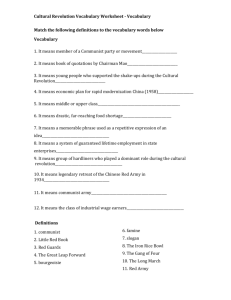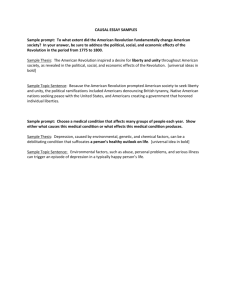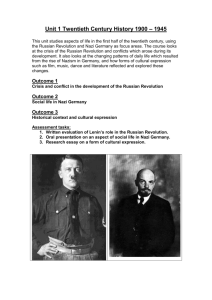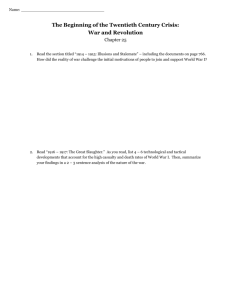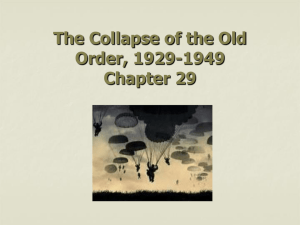1) The mid-1920s in western Europe could best be described as a
advertisement
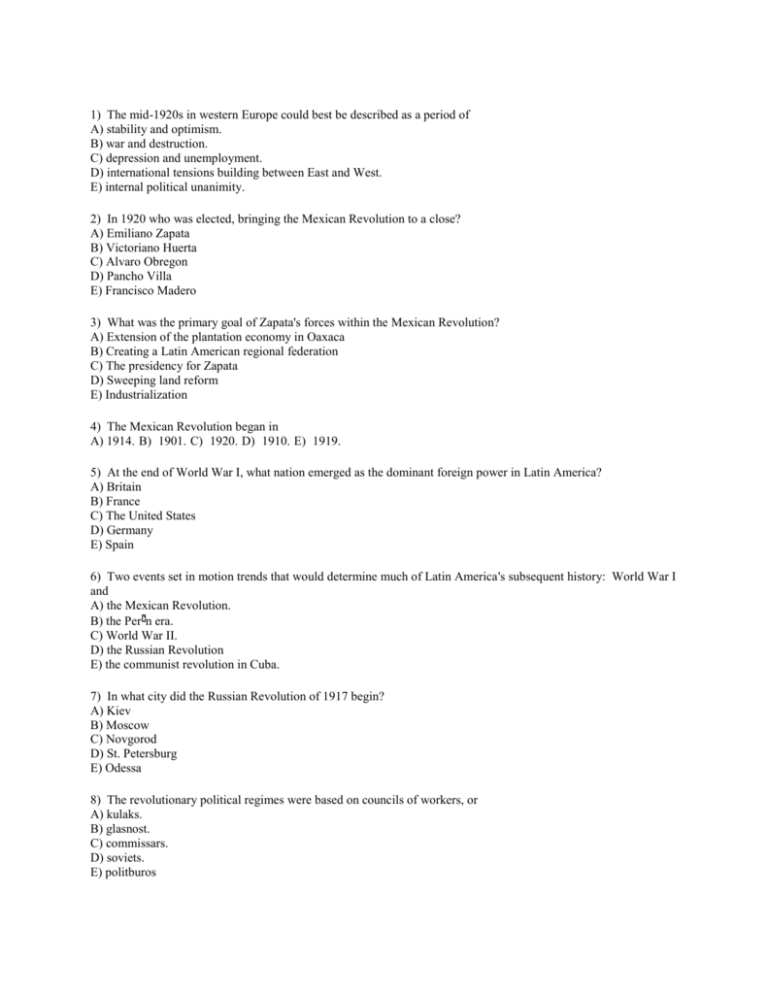
1) The mid-1920s in western Europe could best be described as a period of A) stability and optimism. B) war and destruction. C) depression and unemployment. D) international tensions building between East and West. E) internal political unanimity. 2) In 1920 who was elected, bringing the Mexican Revolution to a close? A) Emiliano Zapata B) Victoriano Huerta C) Alvaro Obregon D) Pancho Villa E) Francisco Madero 3) What was the primary goal of Zapata's forces within the Mexican Revolution? A) Extension of the plantation economy in Oaxaca B) Creating a Latin American regional federation C) The presidency for Zapata D) Sweeping land reform E) Industrialization 4) The Mexican Revolution began in A) 1914. B) 1901. C) 1920. D) 1910. E) 1919. 5) At the end of World War I, what nation emerged as the dominant foreign power in Latin America? A) Britain B) France C) The United States D) Germany E) Spain 6) Two events set in motion trends that would determine much of Latin America's subsequent history: World War I and A) the Mexican Revolution. n era. B) the Per C) World War II. D) the Russian Revolution E) the communist revolution in Cuba. 7) In what city did the Russian Revolution of 1917 begin? A) Kiev B) Moscow C) Novgorod D) St. Petersburg E) Odessa 8) The revolutionary political regimes were based on councils of workers, or A) kulaks. B) glasnost. C) commissars. D) soviets. E) politburos 9) What group succeeded the initial revolutionary government of Russia? A) Kerensky's liberals B) Lenin's Bolsheviks C) Molotov's Mensheviks D) Trotsky's conservatives E) Bakunin's anarchists 10) What was Lenin's solution to Russian participation in World War I? A) He launched a massive offensive campaign that carried Russian forces deep within Germany. B) He implemented a trench warfare strategy which caused the German advance to stop. C) He immediately demanded that his British and French allies send humanitarian, economic, and military aid to the Eastern Front. D) He successfully achieved a significant role at the Versailles peace negotiations. E) He negotiated a peace treaty with the Germans and surrendered huge amounts of land on Russia's western border. 11) The last Manchu emperor abdicated in A) 1939. B) 1945. C) 1900. D) 1923. E) 1912. 12) What foreign power played a major factor in Chinese domestic history from the mid-1890s to 1945? A) Vietnam B) Russia C) Japan D) The United States E) Britain 13) The leader of the Revolutionary Alliance, a loose coalition of anti-Qing political groups that spearheaded the 1911 revolt, was A) Mao Zedong. B) Sun Yat-sen. C) Chiang Kai-shek. D) Yuan Shikai. E) Li Dazhao 14) The initial goal of the May Fourth movement was A) Chinese subjection to Japan. B) Communist insurrection. C) ridding China of all Western influences. D) the creation of a liberal democracy along Western lines. E) ending the practice of Confucianism. 15) Most of the members of the early May Fourth movement were A) Communists. B) warlords. C) peasants. D) merchants E) intellectuals and students. 16) What made Chinese thinkers aware of a possible Marxist solution to China's ills? A) The Russian revolution of 1917 B) The Russian revolution of 1905 C) The Japanese example D) Frederick Engels's visit to China in 1912 E) The revolutions of 1848 17) How did early Chinese Marxist philosophy differ from Lenin's? A) Chinese thinkers stressed the gradualist approach to political change. B) The study circle at the University of Beijing saw the peasants as the vanguard of revolution. C) Chinese philosophers emphasized the role of the proletariat in the revolution. D) The dictatorship of the proletariat would last forever. E) Sun Yat-sen taught that the revolution could only occur after the complete industrialization of China. 18) Early Marxist philosophers in China characterized all of China's society as A) bourgeois. B) Westernized. C) peasant. D) proletarian. E) capitalist. 19) In 1919, Sun Yat-sen returned to China and attempted to unify the various political organizations struggling for political influence in China by reorganizing the revolutionary movement under what name? A) The Nationalist Party of China B) The Socialist Youth Corps C) The Party of the Long March D) The May Fourth movement E) The Red Army 20) The Nationalist Party's greatest failure was its inability to A) deal with the social and economic crisis of the Chinese peasantry. B) forge an alliance with Japan. C) rid itself of its ties to the Qing dynasty. D) industrialize China. E) create a military wing of the party. 21) What early Communist leader emphasized the role of the peasantry in revolutionary solutions to Chinese problems? A) Chiang Kai-shek B) Mao Zedong C) Sun Yat-sen D) Yuan Shikai E) Puyi 22) Who emerged as the head of the Nationalist Party and de facto ruler of China by the late 1920s? A) Li Dizhao B) Sun Yat-sen C) Mao Zedong D) Chiang Kai-shek E) Yuan Shikai 23) The Long March refers to A) the invasion of northern China by the U.S.S.R. in 1934. B) the march of 90,000 communists from Hunan to Shaanxi province. C) the Nationalist Party progression from minor movement to ascendancy in China. D) Chiang Kai-shek's assault on the communist stronghold in Beijing. E) the humiliating exportation of Chinese prisoners to Japan. 24) What event historically triggered the Great Depression? A) The Long March B) Collapse of the American stock market C) The attack of Pearl Harbor D) World War I E) World War II 25) Which of the following statements is most correct? A) Its duration was typical of most economic failures. B) The effects of the Great Depression were hardest in the U.S.S.R. C) The intensity of the Great Depression had no similar precedence in the history of industrial society. D) The intensity of the Great Depression had similar precedence in the history of industrial society. E) Most world governments saw the Depression coming, but were unable to affect it. 26) Which of the following was NOT a factor leading to the development of fascism in Germany? A) The division of Germany into zones of occupation by the victorious Allies in World War I B) The rise of leaders such as Hitler C) The impact of the depression D) Treaty arrangements that forced Germany to accept the blame for World War I E) The recent and shaky tradition of parliamentary government 27) The western portion of Czechoslovakia that contained predominately German-speaking peoples was called A) Slovenia. B) the Ruhlstaag. C) the Sudetenland. D) Serbia E) Anschluss. 28) Which of the following was NOT part of Adolf Hitler's political program? A) A return to more traditional ways B) Alliances with socialist parties in Germany C) Creation of a secret police known as the Gestapo D) A glorious foreign policy designed to undo the disgrace of Versailles E) The need for unity and the hopeless division of parliamentary politics 29) In Germany under Hitler, government economic planning A) helped to restore production levels by emphasizing armament construction. B) was modeled on the programs of the American New Deal. C) was focused on a return to a preindustrial system. D) did not exist. E) was based on the economic theory of John Maynard Keynes. 30) Hitler's foreign and military policies were based on A) England's foreign and military policies. B) working with the League of Nations. C) conquest without warfare. D) preparation for war. E) elimination of the Jews. 31) In the election of 1932, Hitler's National Socialist Party A) failed to achieve a majority, but won more votes than any other single party. B) was prevented from participating. C) formed an alliance with the Communist Party to win the election. D) boycotted the electoral process. E) received a majority of all votes cast in Germany. 32) The type of government that Hitler established in Germany can best be described as A) anarchic. B) democratic. C) communist. D) totalitarian. E) liberal. 33) The blatantly fascist political party in Spain that backed General Franco was called A) the Escriba. B) the NEP C) the Grange. D) the Lumina. E) the Falange. 34) What military leader in Argentina broadened the base of support for the conservative government by appealing to labor groups and by utilizing the popularity of his wife? A) Juan D. Peron B) Ernesto Chavez C) Fidel Castro D) Victorio Huerta E) Julio Iglesias 35) As president of Argentina, Peron forged an alliance among all of the following groups EXCEPT A) the industrialists. B) the bureaucracy. C) the nationalists D) the workers. E) the military. 36) The wealthy, commercially oriented peasants who controlled most of Russian land were called A) commissars. B) serfs C) zemstvoes. D) kulaks. E) dumas. 37) What was the Soviet agricultural policy immediately following Stalin's concentration of power in 1928? A) Equitable redistribution of land among all peasants B) NEP programs C) Collectivization D) Commercialization E) Free-market structure 38) By 1936 the Japanese controlled what percentage of world trade? A) 8 percent B) 10 percent C) More than 20 percent D) 15 percent E) Less than 4 percent 39) Which of the following statements concerning the depression in Japan is most accurate? A) The total concentration of the government on military aggression led to an ineffective response to the depression. B) Due to government controls, the depression never affected the Japanese. C) Western nations such as Britian and the United States began a massive investment program in Japan. D) The Japanese government failed to take any direct action to modify the impact of the depression. E) After initial results that caused great misery, Japan suffered far less than many Western nations because of effective government action. 40) Which of the following statements best describes the Japanese government during the 1920s and early 1930s? A) Japanese politics were fully democratic, leading to the growth of communism in Japan. B) Labor unions began to exert increasing control over economic policy in the aftermath of the government's failure to take direct action during the depression. C) Japan was ruled exclusively be a strong liberal party that dominated the lower house of parliament. D) The rise of the Communist Party in Japan led to a major reorganization of the government. E) Japan's oligarchic political structure allowed elite groups to negotiate with each other for appropriate policy and allowed military leaders to take a growing role. 41) The leading military figure in the Japanese government following the failed coup of 1936 was A) Kendo Nobunaga. B) Korekiyo Takahashi. C) Ikura Kansatsu. D) Teoke Tomomi. E) Tojo Hideki. 42) Which of the following resulted from Stalin's agricultural policies? A) Kulaks were able to achieve control over most of the agricultural lands of Russia. B) Agricultural production remained a major weakness in the Soviet economy, demanding a higher percentage of the work force than was common under industrialization. C) Agricultural planning was non-existent, as small farmers continued to control most of Russian productivity. D) Peasants were presented with real market incentives for increased production. E) The Soviets had to import grain from their western neighbors and China. 43) Stalin's system of economic planning occurred under the A) New Deal. B) ACT. C) five-year plans. D) kulaks. E) NEP. 44) The Communist Party was run by a top committee, the A) Politburo. B) Duma. C) soviets. D) Supreme Council E) Supreme Soviet. 45) Which of the following was NOT typical of the Soviet economy? A) Need to create a massive armaments industry B) Emphasis on rigid planning C) Emphasis on heavy industrial goods D) Control of virtually all economic sectors E) Ready availability of consumer goods 46) Persia became what modern country in 1935? A) Syria B) Kuwait C) Iran D) Israel E) Iraq
